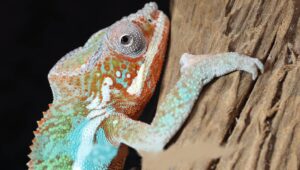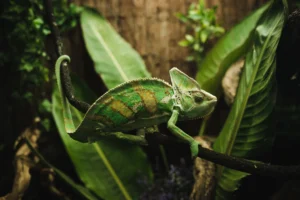A stressed chameleon often displays dark or dull coloring and may show a loss of appetite. It might also remain stationary or attempt to hide more frequently than usual.
Chameleons, the masters of disguise, are incredibly sensitive to their environment. They require a habitat that mimics their natural ecosystem to thrive, and when certain needs are not met, they exhibit stress symptoms. Recognizing these signs early is crucial for the wellbeing of your pet.
An anxious chameleon will also demonstrate aggression, hissing, and puffing up when approached, which are clear indications that it is feeling threatened or uncomfortable. Understanding these behavioral cues is vital for chameleon owners to ensure their pets lead a healthy, stress-free life. Quick responses to stress symptoms can prevent further health issues and improve the overall longevity of your chameleon.
Recognizing Stress In Chameleons
Chameleons are sensitive creatures, attuned to their environment. Stress can significantly impact their health. Understanding how to spot signs of stress in your chameleon is crucial.
Physical Indicators Of Stress
Several physical signs may suggest your chameleon feels stressed:
- Color Change: While chameleons are known for changing colors, sudden or unusual color shifts can signal stress.
- Eye Bulging: Chameleons might bulge their eyes more frequently when stressed.
- Poor Shedding: Difficulty shedding skin is often a stress indicator.
- Appetite Loss: A lack of interest in food may also point to stress.
Dark or dull colors can also be a clue. Chameleons often display darker colors when not feeling well.
Behavioral Changes Signifying Discomfort
Behavior is a tell-tale sign of a chameleon’s mood. Watch out for these behaviors:
| Behavior | Significance |
|---|---|
| Hissing or Biting: | May suggest your chameleon is feeling threatened or irritated. |
| Lack of Movement: | Unusual inactivity can be a sign of stress or illness. |
| Reduced Grip Strength: | Weakness in grip could indicate stress or other health issues. |
Atypical behavior such as retreating from the heat lamp, avoiding water or typical climbing activities could also signal distress.
Common Stressors For Chameleons
Identifying stress in chameleons is crucial for their well-being. These unique reptiles show stress in subtle ways, often related to their environment or social needs. Let’s explore the common factors that can negatively impact your chameleon’s life.
Environmental Factors Affecting Well-being
Environmental Factors Affecting Well-being
Chameleons are sensitive to their habitats. A poorly set up enclosure can lead to stress. Here’s what to watch for:
- Temperature: Too hot or too cold terrarium temperatures stress them.
- Lighting: They need a cycle of light and dark, mimicking the sun.
- Space: A cramped space can trigger anxiety.
- Humidity: Incorrect levels can cause discomfort.
- Cleanliness: Dirty enclosures are a no-go for these creatures.
- Plants: Lack of foliage for hiding can leave them feeling exposed.
Social Interactions and Solitude Needs
Social Interactions And Solitude Needs
Despite their colorful appearance, chameleons are not the social butterflies of the reptile world. Respect their need for solitude:
| Social Factor | Impact on Stress |
|---|---|
| Too much handling | Increases stress |
| Exposure to predators | Triggers fear |
| Viewing another chameleon | Can cause territorial stress |
Handle with care and always be mindful of their body language. Give them a stress-free home with plenty of alone time to stay healthy.
Colors Tell The Tale
Chameleons are remarkable creatures known for their ability to change colors. This ability isn’t just for show; it’s a window into their well-being. Understanding a chameleon’s palette can reveal if they’re stressed or content.
Decoding Chameleon Color Patterns
Chameleon colors serve as a special language that signals their mood, health, and intentions. Vivid and intense colors often mean a chameleon is actively communicating. Muted or dark colors might suggest discomfort or a need to hide. Recognizing these patterns is key to decoding their health.
Stress-related Color Changes
Stress changes a chameleon’s color in distinct ways. Darker hues can indicate fear or irritation, while patchy or dull colors may mean a health issue. Spotting these changes early helps you react to stressors promptly, ensuring your chameleon’s happiness.
| Color Change | Possible Stress Factor |
|---|---|
| Darker Hues | Fear, Cold, Aggression |
| Dull or Muddy Colors | Illness, Low Energy |
| Black Spots | Physical Stress, Uncomfortable Habitat |
- Regular observation helps you understand your chameleon’s normal color range.
- Subtle shifts can signal stress before it becomes critical.
Each chameleon has unique color patterns. Maintain a stress-free environment tailored to your specific pet’s needs.
Listen To Body Language
Chameleons speak without words. Their body language tells us how they feel. Stress can harm their health. Knowing stress signs helps chameleons stay happy. Let’s interpret their silent messages together.
Posture And Movement As Stress Indicators
A chameleon’s posture can signal stress. Look closely and you might see:
- Puffed-up body: They inflate to seem bigger when scared.
- Rocking movements: Nervous chameleons might rock back and forth.
- Slow movement: Their slow pace can mean unease.
- Color change: Sudden color shifts often show stress.
These body signs shout ‘I’m stressed!’ in chameleon talk.
Eye Movement And Its Significance
Chameleons’ eyes move in all directions. They do this to see around.
| Eye Movement | What It Might Mean |
|---|---|
| Bulging eyes: | It could mean they’re scared or curious. |
| Fast darting: | Quick eye movements may show fear or excitement. |
| Eyes closed during the day: | Closed eyes can be a sign they’re not happy or not feeling well. |
Use these hints to gauge your chameleon’s comfort level.
Maintaining A Stress-free Habitat
Chameleons are sensitive creatures. Their well-being hinges on a calm environment. A stress-free habitat is crucial for their health. Spotting the signs of stress in these colorful reptiles early helps to make needed changes. They thrive when their home mimics their natural habitat.
Ideal Enclosure Setup For Comfort
Creating a tranquil home for chameleons promotes their relaxation. The enclosure should be large and spacious. This allows them to roam, climb, and explore. The habitat must have:
- Ample foliage for hiding: Plants give chameleons a sense of security.
- Proper lighting: UVB lights stimulate natural sunlight, aiding their health.
- Adequate ventilation: Good airflow prevents respiratory issues.
- Temperature gradients: Areas to bask and cool down keep them comfortable.
Place branches at various angles and heights for climbing. Ensure that at least one hideaway spot is available. This lets them escape from view, reducing stress.
The Role Of Diet And Nutrition
A chameleon’s diet directly affects their stress levels. A varied diet keeps them healthy and happy. Vital components of their diet include:
| Food Type | Benefit |
|---|---|
| Live insects | Stimulates hunting instinct. |
| Vegetables | Adds fiber for digestion. |
| Calcium supplements | Prevents bone disorders. |
Ensure the insects are gut-loaded for extra nutrition. Dust food with calcium and vitamins regularly. Fresh, clean water should be available, ideally through a dripping system. This meets their hydration needs in a familiar way.
When To Seek Professional Help
Identifying stress in chameleons is crucial for their wellbeing. But when does stress indicate a trip to the professional?
It’s vital to recognize the signs early to ensure your reptile friend receives the best care. Let’s explore these signs and understand the right time to seek expert advice.
Identifying Persistent Stress Symptoms
Chameleons can’t speak, but their behaviors and physical signs can tell a lot about their health. Persistent stress symptoms are a red flag. These symptoms might include:
- Color changes that are more dramatic than the typical camouflage
- Appetite loss where your chameleon eats less or refuses food altogether
- Decreased activity level and lethargy unlike their normal behavior
- Visible signs of aggression or fear when they usually are not
- Repetitive behaviors such as scratching or biting the enclosure
These signs, especially when persistent or worsening, signal that it’s time for professional input.
Consulting With A Herpetologist Or Veterinarian
When home remedies fail, and stress signs continue, it’s essential to consult with a specialist. Here’s why:
| Reasons to Consult a Specialist |
|---|
| 1. To get a precise diagnosis of what’s causing the stress |
| 2. To receive professional care guidance for your chameleon |
| 3. To identify any underlying illnesses contributing to the stress |
| 4. To get recommendations on habitat adjustments or dietary changes |
Act swiftly when stress symptoms persist; a vet or herpetologist can offer tailored care that might save your chameleon’s life. They have the expertise to interpret symptoms and provide targeted treatments.
Remember, a stressed chameleon is not just an unhappy one; it can be a sign of serious health issues.
Frequently Asked Questions Of How Do You Know If Your Chameleon Is Stressed?
How Do You Calm A Stressed Chameleon?
To calm a stressed chameleon, ensure a quiet environment, maintain proper habitat temperature, provide hiding places, handle gently if necessary, and avoid sudden movements around them. Regular, consistent care routines also promote a sense of security.
What Color Do Chameleons Turn When They Are Stressed?
Chameleons often turn darker colors when they experience stress. This change helps communicate their distress and may discourage other animals from approaching.
How Do I Know If My Chameleon Is Ok?
Check your chameleon for bright coloration, active eyes, a strong grip, regular eating habits, and daily activity to ensure its well-being. Signs of discomfort or illness include lethargy, discolored skin, and a lack of appetite.
What Does An Unhealthy Chameleon Look Like?
An unhealthy chameleon may show signs like dull or darkened skin, sunken eyes, a loss of appetite, lethargy, and weight loss. Visible bones or weak limbs also indicate health issues.
Conclusion
Recognizing the signs of stress in your chameleon is vital for its well-being. From color changes to eating habits, the indicators are clear. Addressing these symptoms promptly ensures a happier, healthier pet. Keep a vigilant eye on your chameleon; their vibrant life may depend on it.
Seek expert advice when necessary, and provide a serene habitat for your reptilian friend.



